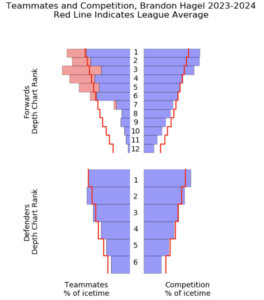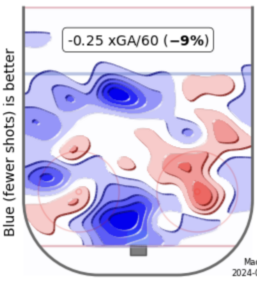25-year-old forward Brandon Hagel is proving his case for the Frank J. Selke Trophy this season. The former Chicago Blackhawks draft pick continues to grow, eclipsing a career-high in points. Appearing in 76 games this season, the Saskatoon native has 24 goals and 46 assists for 70 points while playing over 19 minutes per game.
The Selke Trophy goes to the forward with the best defensive skill in the league. When discussing the top defensive forwards in the National Hockey League, Aleksander Barkov, Mark Stone, and Mitch Marner immediately come to mind. However, the conversation should include the Tampa Bay Lightning star forward as well, but he’s received minimal recognition.
Brandon Hagel Belongs in Selke Trophy Race With Strong Defensive Play
Brandon Hagel perfectly fits the mold of a Selke Trophy winner. The speedy winger provides leadership and a non-stop work ethic to the Lightning. Additionally, Hagel is the most consistent player on the roster and never has a bad game. These character traits and intangibles explain his defensive prowess with the Bolts.
Outside of the non-quantitative factors, Hagel faces elite competition alongside his linemate, Anthony Cirelli. Micah Blake McCurdy invented “Teammate & Competition” charts on Hockey Viz to showcase the quality of competition a player faces. For this case, focus on the right side of the chart. The blue bars on the right indicate Hagel predominately plays against opponents’ top lines and defensive pairings.

Other Contributing Factors To Hagel’s Case
Shot Maps
Defensive zone shot maps are another tool to measure defensive performance. The charts display where a team takes unblocked shot attempts and how frequently. Red regions indicate a team generates more shots than the league average, whereas blue regions indicate a team generates fewer shots than the league average. Below is Hagel’s defensive zone shot map. The deep blue areas in the slot specify Hagel does not allow high-quality scoring chances.

In conclusion, when Hagel is on the ice, the Lightning allow expected goals at a rate nine percent better than the league average this season. Those are elite, Selke-worthy results.
Relative to Teammate
While Hagel limits the quantity and quality of scoring chances, are these results due to the team around him? A player’s role, competition, and team structure skew their defensive analytics sometimes. However, Hagel beats all three of these narratives. The shot maps and combination charts show Hagel plays a top-six role while facing elite competition. Furthermore, his defensive metrics are significantly better than the rest of the Lightning forward core.
Hagel ranks 15th in expected goals against per hour relative to teammates (-0.21 RELTM xGA/60) amongst forwards with over 900 minutes at 5v5 via Evolving Hockey. In other words, Hagel’s expected goals against per 60 rate is 0.21 higher than the Lightning’s team average. He is well above the bar defensively in Tampa Bay and is not receiving much help outside of Cirelli, making his results even more impressive.
Impactful On The Penalty Kill
Another reason to consider Hagel for the Selke Trophy is his shorthanded abilities. As of April 5th, the Tampa Bay penalty kill ranks fifth in the league, operating at an 83% success rate. Hagel ranks 29th amongst forwards in shorthanded time on ice this season. Moreover, Hagel ranks 24th in goals against per hour shorthanded (5.36 GA/60) amongst forwards with over 75 minutes of penalty kill time this year. He is a top-25 penalty killer in the league while providing elite defensive results at even strength.
How Much Recognition Should Hagel Receive For The Selke Trophy?
Following a deep, objective analysis of numerous defensive numbers with proper context, Hagel belongs in the top three for Selke Trophy Candidates this season. Hagel plays a vital top-six role for the Lightning, matches up against the opponent’s top lines, and posts elite results on an average defensive team. Furthermore, he provides immense value on the penalty kill. With that, Hagel belongs in the conversation with players like Barkov, Stone, and Marner for the best defensive forward in hockey.
Analytics via Evolving Hockey and Hockey Viz (Paid Subscription Required)
Main Photo: John E. Sokolowski-USA TODAY Sports






